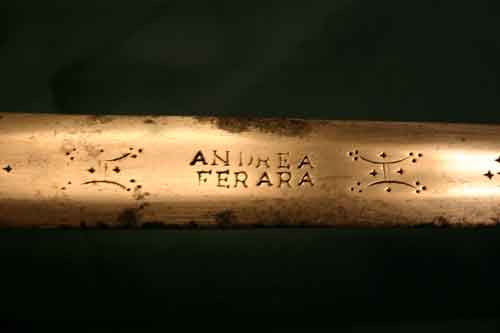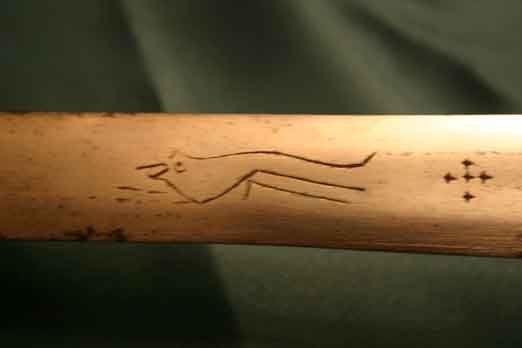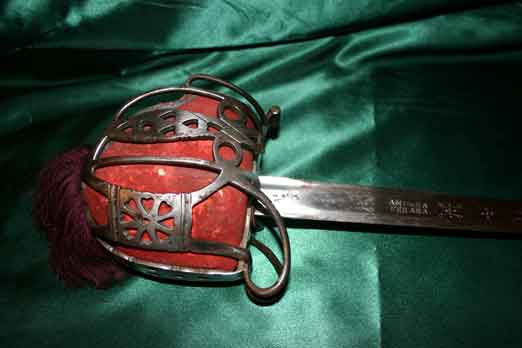Posts: 79
Tue 20 Jul, 2004 11:16 pm
An antique Andrea Ferara Scottish sword!
Last edited by Todd Salazar on Wed 21 Jul, 2004 9:31 pm; edited 1 time in total
Posts: 79
Wed 21 Jul, 2004 7:53 am
Does anybody know the significance of the animal (a bird, frog or the Solingen running wolf perhaps) carving in the blade? Can it help me to identify the name of the actual blademaker and age of the blade? I'm going to attach a picture of the animal from the other side of the blade as well for everybodys reference.
Thanks,
Todd
 Attachment: 6.85 KB
Attachment: 6.85 KB
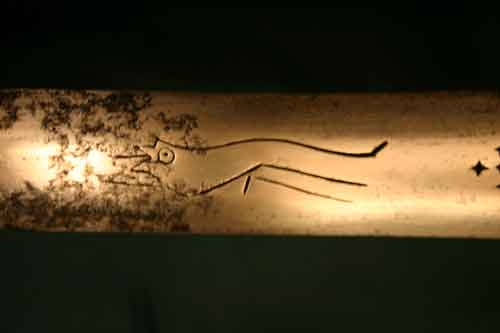
Last edited by Todd Salazar on Wed 21 Jul, 2004 11:44 am; edited 2 times in total
Posts: 1,757 Location: Storvreta, Sweden
Wed 21 Jul, 2004 11:18 am
Nice sword!
The animal is the "Solingen" wolf.
The craftsmen in Solingen pirated it from Passau smiths in the 14th C (who were doing high quality work that sold well).
It was used by other bladesmiths in later times to denote quality and ride on the fame of the german smiths.
The same goes for the Andrea Ferrara name.
This Italian master was widely admired and his fame "inspired" other makers to "emulate" his work...
The blade could well be a german blade, I would guess.
Posts: 6 Location: Henrico,Va
Wed 21 Jul, 2004 2:21 pm
Solingen's "Passau Wolf" markings.
This may well be a copy of the Passau Wolf mark ...But the few I have seen have normally been straight and not
slight curved like the one on your blade.This may have been done by a "IN the field armorer"or even done
by some of the Smiths in Spain like the toledo works,Ect this would most likely have been done from about
1809-1814 and most likely may have been a Highland Light Infantry man of of the line.or may have had the
wolf"bird" added when he was attached with the Light Divison with the Kings German Legion(KGL)
and may have seen the Wolf their and liked it. I do not feel that it was added to make the blade look to be of high
quality workmanship. Solingen's mark did not really start to be well known for Quality weapons better than
English manufacturing till after the introduction of Krupps Fluid Steel process where without question they held
the superior metalugical skills.
I hope this has helped some and not just muddied the water.I would seek more information from the Imperial War museum of England the folks their are most helpful.Also try the Volks Landstrum Musem in Germany. As
for Andrea Ferrara he was a celbrated Spanish swordsmith who killed his apprentice when he caught him spying on his secret smithing techniques. He fled to Scotland where he joined the court of James V and restarted his trade.This is why
I feel that the "Mark" was made in Spain after the sword was first made and by a Highlander in the Penisula fighting
the french with the Light Division most likely formed with the KGL(kings german legion)I have no proof
only logic and what I know of the makers marks and the time period.
Posts: 1,757 Location: Storvreta, Sweden
Wed 21 Jul, 2004 3:35 pm
Hi Patrick,
I have to disagree with you on some points.
The style of the Solingen/Passau wolf vary a great deal. Some are more angular, other look more like otters or some other sinuous beast. In some cases the "wolf" is only two wawy parallel lines. It is difficult to denote origin or authenticity of the blade from the shape of the wolf alone. If there is nothing else to cause concern, it might be reasonable to think the sword actually is of Solingen manufacture, but we need to keep in mind there were contemporary "fakes".
It is well known that the practise of falsifying well established blade marks go back at least to the 9th C (Mis-spelled ULFBERHT´s) and probably even long before that.
In medieval times the blades from Passau had a wolf and a bishops staff carved and inlayed in the blade. That is what distinguishes Passau blades from Solingen ones. The Solingen blades as a rule had only the wolf, in later times in addition to blade smith stamps.
(Medieval blade smiths often marked their blades on the tang. It was the cutlers proofing mark that usually had the place of honor on the blade. Smiths stamped their marks hot, while cutlers for obvious resons made their markings cold.)
The wolf was certainly put on blades as a mark of quality well before the 19th C. The mark was engraved by the cutlers who did the quality proofing as a mark of approval.
The highest fame or golden days of Solingen blades was perhaps during the 17th C. Solingen supplied thousands of blades/swords to the troops who fought in the 30-years war.
In later times the glory of the bad old days still lingered, and much has been made from that...
Posts: 255 Location: ohio
Wed 21 Jul, 2004 5:48 pm
The running wolf mark looks similar to the markings on Walloon Hilted weapons and probably dates to the 17th century. The Sickle marks to the right of the Ferara mark are consistant with this date and possibly into the 18th century. To me it looks good, the blade really makes the sword!
Posts: 6 Location: Henrico,Va
Wed 21 Jul, 2004 5:55 pm
Hello Peter
Hello Peter
Thank you for your post.If you have more information on the topic or where to find it I would be very grateful
I only have first hand accounts from 30 year war and Napoleonic accounts of troops in the field
and NO true Manufacturing information other than the basics information from the IWM&VLM
as well as a few good books on pre-napoleonic edged weapons.but I can give you a quick overview
of what info I have on Solingen.The city of Solingen was founded in 1374. It has long been an active center for the production of high quality cutlery.
Although they may have changed hands many times several of the knife producers that exist in Solingen today have been around for more than one hundred years. Hermann and Robert Boeker, for example, began production of sabers in 1829 in nearby Remscheid. By 1830 his firm was producing up to 2000 swords per week and employed more than 100 smiths, grinders and laborers. Later Hermann Boeker would emigrate to the US and founded H. Boeker & Co. in New York. Robert brought the Boeker company to Canada and Mexico in 1865. In 1869 Heinrich Boeker moved the short distance to Solingen, Germany which was fast becoming a hot bed for industrial tool production. He founded Heinr. Boeker and Co. which produced shaving blades, scissors and pocket knives. As the overseas demand for pocket knives grew, Heinr. Boeker and Co. began to produce more pocket knives and fewer scissors and razors. As early as the turn of the century the majority of Boeker knives have been exported to the US and distributed by H. Boker & Co. in New York. J.A Henckels is another company known for their excellence in manufacturing high quality knives and cutlery. They share a similar long term history in the city of Solingen. In 1731, Johann Peter Henckels, a knife maker based in Solingen, registered the first version of the twin figure symbol we all associate with Henckels knives. In the 260 years since then the symbol has gone through some design changes as can be seen below. It is now one of the oldest trademarks in existence. Here is a brief outline of the history of the companies pivotal events provided by the Zwilling J.A. Henckels Co. "1731: Peter Henckels registers the TWIN trademark with Solingens Cutler’s Guild. 1818: Johann Abraham Henckels opens the Company’s first branch office in Berlin.
I hope to hear from you soon! Thanks!
Posts: 455 Location: Kentucky USA
Thu 22 Jul, 2004 8:03 pm
Re: An antique Andrea Ferara Scottish sword!
| Todd Salazar wrote: |
Hello,
And now for the old! I have also recently purchased an antique Andrea Ferara sword that probably dates to around the late half of the 18th century. There are no markings on the basket but the blade has several marks. I believe that the basket and handle were probably redone sometime in the 19th century for a soldier in one of the Scottish regiments. However, I am not an expert so I thought I would get everybody's opinions on the sword. Thanks for your comments! |
Where is Mac & ElJay when we need them. lol :cool:
Hi Todd,
If we can presume that the blade is genuine, I would say that your assumptions are correct. It was not uncommon for basket-hilts to be mounted on older blades.
Although, I think this is the first one that I have seen that features a mid-late 19th/early 20th century regimental hilt with an older blade. Interesting.
As a side note, you can take a look through this myArmoury.com album and see that blades cross sections varied greatly (ex. multi-fullered, hexagonal, flat, etc.):
Scottish/English basket-hilted swords
http://www.myArmoury.com/albums/thumbnails.php?album=19
Here is a blade similar in profile to that of yours. (circa 18th century)
 Attachment: 113.06 KB
Attachment: 113.06 KB

Posts: 79
Thu 22 Jul, 2004 8:49 pm
Hello again,
The gentleman that I bought it from in the U.K. stated that he found it at auction and that it was described as an old family blade from the 18th century that had been updated with a new basket and handle sometime in the 19th century. As for the blade and it's markings, it does appear that it could've come from the 18th century. Unfortunately, somebody decided along the way that the basket hilt didn't live up to other swords of it's time so they decided to change it. I know that I wouldn't have done this, but they did. Would it be worth it to possibly look for an antique basket from the time of the blade (around 1745) and then attempt to reunite this old blade with an old basket? Let me know how all of you feel about this? Or would I be harming the blade by attempting to add back an older basket to match the blade thus making a bigger mess of it all? Thanks again for everybodys comments! :D
Thanks,
Todd
Posts: 455 Location: Kentucky USA
Thu 22 Jul, 2004 9:21 pm
| Todd Salazar wrote: |
| Would it be worth it to possibly look for an antique basket from the time of the blade (around 1745) and then attempt to reunite this old blade with an old basket? |
My opinion. No, You may have some trouble finding a period basket to match.
| Quote: |
| Or would I be harming the blade by attempting to add back an older basket to match the blade thus making a bigger mess of it all? |
Yes, well, if you were able to find some antique hilt components it will most likely require some custom restoration work that may be quite expensive.
final thoughts...
Todd,
What you have is a unique sword, no need to tamper with it. :cool: There are many examples of 18th century basket hilts mounted on 17th century blades (some even earlier.)
Posts: 455 Location: Kentucky USA
Thu 22 Jul, 2004 9:29 pm
| Quote: |
| Unfortunately, somebody decided along the way that the basket hilt didn't live up to other swords of it's time so they decided to change it. |
It is also possible that the soldier came across a bare blade, and decided to have it mounted upon his basket. Bare blades are more common than bare baskets.
Posts: 79
Thu 22 Jul, 2004 9:35 pm
Then that settles it, I'm going to leave it as it is and enjoy it for what it is! :) Thanks to everybody for your insight and thoughts!
-Todd
Posts: 455 Location: Thailand
Fri 23 Jul, 2004 8:44 pm
Hi All,
Getting to this discussion late, but am glad to see that Todd has decided to leave the sword as is. Over the years I've seen a LOT of later hilts with earlier blades, and unless there's something obviously "wrong" with the feel of the sword, or there's evidence of recent work, it's best to assume that someone back when, for whatever reason, had an earlier blade mounted in a then-current hilt.
--ElJay
Posts: 1 Location: Houston, TX
Sat 25 Sep, 2010 12:09 am
Andrea Ferara blades?
You can find the answer to this and many other questions on Andrea Ferara here:
http://www.yourphotocard.com/Ascanius/Andrew_Ferrara_swords.pdf
Posts: 1,001 Location: Roanoke,Va
Sat 25 Sep, 2010 2:31 am
a friend, RSG co-founder and rabid antique Scottish sword collector of mine has been looking of one of these blades
to add to his collection. As mentioned, the blade itself is the kicker. To have the "running wolf", the Andrea Ferara AND the eye lash marks is vital in dating the blade. Happened all the time with these Scot basket hilts. My friend has one actually from Culloden field that's mounted with a cut down 2 handed claymore blade with eyelash marks....blade dated late 16th c.
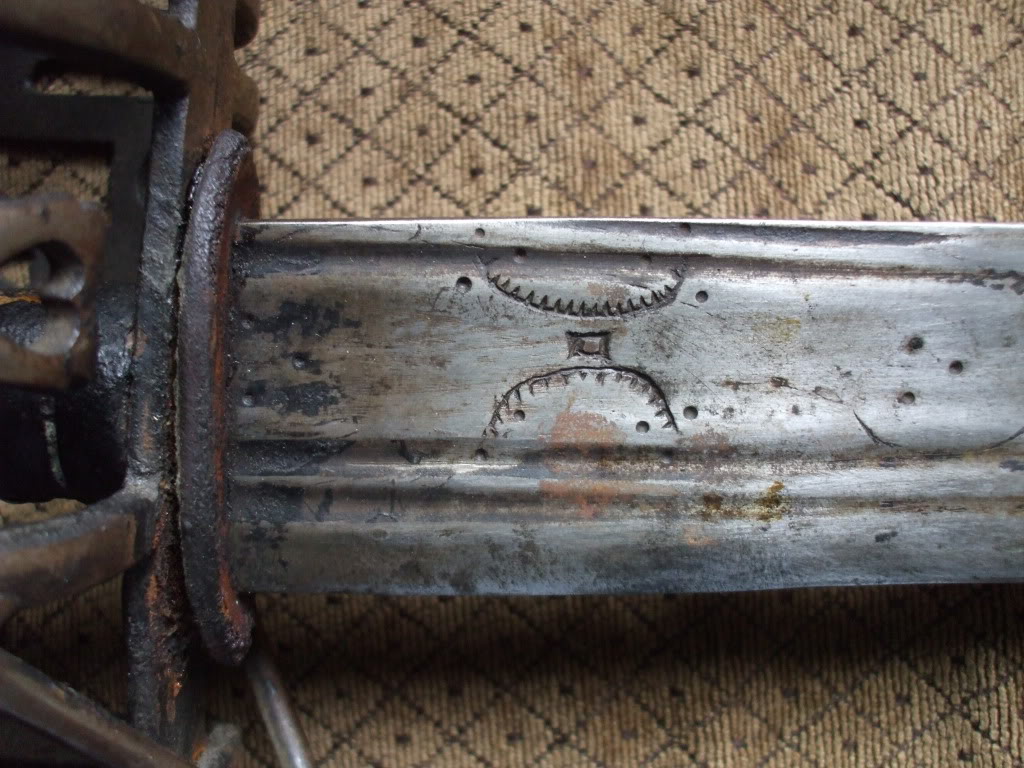

Posts: 1,978 Location: Nipmuc USA
Sat 25 Sep, 2010 3:44 am
That's a nice little pdf file there David, thanks for sharing. I was reading elsewhere and came across an interesting discussion about blade markings and there seems to be a contention that Andrea Ferrara may have not been a name at all but rather an indication of worthiness.
http://www.vikingsword.com/vb/showthread.php?t=12450
This was new to me and the Eisenhauer marked blades from the 19th century on sort of click in the same way. I am only batting about 90 these days but now I am also revisiting some sideline thoughts of even earlier Uhlbert markings on sword blades. But... don't mind me. I am often in a state of stupor.
Cheers
GC
Posts: 487
Sat 25 Sep, 2010 11:46 am
The hilt on the sword seems to be a M1821 baskethilt pattern for highland regiments serving in the British army. Interesting to speculate how an earlier blade, perhaps a family heirloom might have been fitted to a regulation pattern basket for a currently serving officer.
Posts: 54
Sat 25 Sep, 2010 12:15 pm
Antique dealers are notorious for fabricating artefacts. And many did a fair amount of shuffling about of sword parts to meet the insatiable demand for “authentic” Scottish weapons in Victorian and Edwardian times. Especially to flog off on gullible American tourists and naive museums. A nice old looking hand written tag, a good story by a well dressed, “reputable” antique dealer, instant provenance!
The same as the Japanese who fitted up old blades in new, gaudy over done fittings ("Hama-mono" or "Hama-yuki") to sell to the tourist who wanted an authentic samurai sword!
Some people only see what they want to see, and buy it they do!
Posts: 630 Location: Tucson
Sat 25 Sep, 2010 10:21 pm
I am afraid I am going to be a bit contrarian on this issue...... I know we have had this discussion about 17th and 18th c blades mated with pattern 1821 Victorian or Edwardian era hilts many times before - but it is still my understanding that a serving officer could not use such a combination while on active duty as his service sword. And as has been mentioned before - note how in all of these cases of older blades on pattern 1821 hilts, none of them ( that I have ever seen) are paired with an original Victorian/Edwardian scabbard, and none of them are ever provenanced to senior officers.
Remember - we know that officers from the 1840s on were not allowed to carry earlier 19th c blades (m1803s and 1796LC's for example) - many of which were still in fabulous shape in the Victorian period - why would they have been allowed to carry a late 17th c blade? I thnk this is in the category of caveat emptor........
That is not to say that a family could not have taken an heirloom blade and had it mounted up on a "new" hilt for hanging in the hallway or office - I am not saying all of these mismatches are dealer created "fakes", but i am generally very skeptical about these legends about Victorian officers using family heirloom blades on regulation hilts.
as usual your mileage may vary. tr
Posts: 487
Sun 26 Sep, 2010 9:54 am
Thom, that's a good observation. I was fixated on the h8ilt and didn't even stop to think that the blade was way too wide to fit in a regulation scabbard!
You
cannot post new topics in this forum
You
cannot reply to topics in this forum
You
cannot edit your posts in this forum
You
cannot delete your posts in this forum
You
cannot vote in polls in this forum
You
cannot attach files in this forum
You
can download files in this forum

